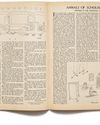
On the outskirts of Santa Barbara, California, between the orchards and the ocean, sits an inconspicuous warehouse, its windows tinted brown and its exterior painted a dull gray. The facility has almost no signage, and its name doesn’t appear on Google Maps. A small label on the door reads “Google AI Quantum.” Inside, the computer is being reinvented from scratch.
In September, Hartmut Neven, the founder of the lab, gave me a tour. Neven, originally from Germany, is a bald fifty seven-year-old who belongs to the modern cast of hybridized executive-mystics. He talked of our quantum future with a blend of scientific precision and psychedelic glee. He wore a leather jacket, a loose-fitting linen shirt festooned with buttons, a pair of jeans with zippered pockets on the legs, and Velcro sneakers that looked like moon boots. “As my team knows, I never miss a single Burning Man,” he told me.
In the middle of the warehouse floor, an apparatus the size and shape of a ballroom chandelier dangled from metal scaffolding. Bundles of cable snaked down from the top through a series of gold-plated disks to a processor below. The processor, named Sycamore, is a small, rectangular tile, studded with several dozen ports. Sycamore harnesses some of the weirdest properties of physics in order to perform mathematical operations that contravene all human intuition. Once it is connected, the entire unit is placed inside a cylindrical freezer and cooled for more than a day. The processor relies on superconductivity, meaning that, at ultracold temperatures, its resistance to electricity all but disappears. When the temperature surrounding the processor is colder than the deepest void of outer space, the computations can begin.
Diese Geschichte stammt aus der December 19, 2022-Ausgabe von The New Yorker.
Starten Sie Ihre 7-tägige kostenlose Testversion von Magzter GOLD, um auf Tausende kuratierte Premium-Storys sowie über 8.000 Zeitschriften und Zeitungen zuzugreifen.
Bereits Abonnent ? Anmelden
Diese Geschichte stammt aus der December 19, 2022-Ausgabe von The New Yorker.
Starten Sie Ihre 7-tägige kostenlose Testversion von Magzter GOLD, um auf Tausende kuratierte Premium-Storys sowie über 8.000 Zeitschriften und Zeitungen zuzugreifen.
Bereits Abonnent? Anmelden

SUBJECT AND OBJECT
What happened when Lillian Ross profiled Ernest Hemingway.

ROYAL FLUSH
The fall of red.

Roz Chast on George Booth's Cartoons
There's almost nothing I like more than a laughing fit. It is a non-brain response, like an orgasm or a sneeze.

CHUKA
I have always longed to be known, truly known, by another human being. Sometimes we live for years with yearnings that we cannot name.

Rachel Aviv on Janet Malcolm's "Trouble in the Archives"
As Janet Malcolm worked on \"Trouble in the Archives,\" a two-part piece about prominent psychoanalysts who disagreed about Freud, she began a correspondence with Kurt Eissler, the head of the Sigmund Freud Archives.

PERSONAL HISTORY - A VISIT TO MADAM BEDI
I was estranged from my own mother, so a friend tried to lend me his.

AMERICAN CHRONICLES - WAR OF WORDS
Editors, writers, and the making of a magazine.

LIVE FROM NEW YORK
A new docuseries commemorates fifty years of \"Saturday Night Live.\"

TANGLED WEB
An arachnophobe pays homage to the spider.

TROUBLE IN PARADISE
Mike White's mischievous morality plays.